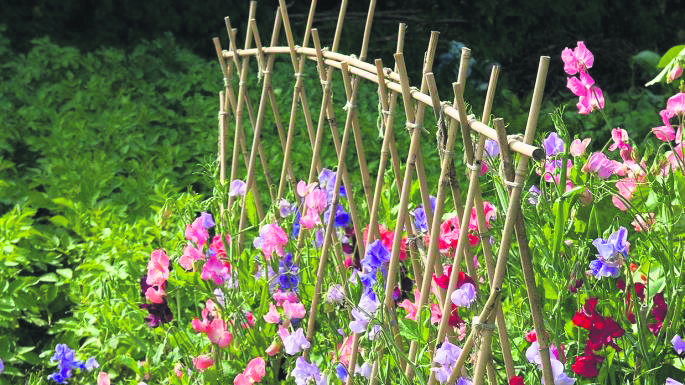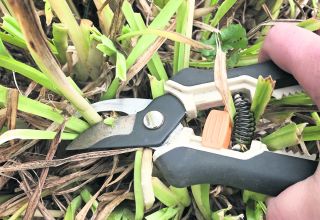May is here, but don’t get overwhelmed by endless lists of gardening jobs – the main jobs are planting out new vegetables, pruning spring flowering shrubs and planting summer bedding.
Prune spring flowering shrubs for next year’s displays
Deciduous shrubs that flower in late winter and spring and early summer need annual pruning to encourage strong, healthy shoots and improve flowering. Annual pruning also prolongs the life of these early-flowering shrubs.
Pruning requirements depend on the type of shrub, but all early-flowering shrubs need routine removal of damaged, diseased or dead wood, as follows:
Cut out any damaged or dead shoots back to their point of origin or to ground level.
Where there are many stems, remove some to ground level to keep the bush open and avoid congestion.
Finally take out any weak, spindly or twiggy shoots right to the point of origin or to ground level so the plant concentrates its resources on strong new shoots that will bear the best flowers.
 …and give forsythia special attention
…and give forsythia special attention
Try to prune forsythia after it has flowered. If you don’t do this every year they quickly get unmanageable and flower less well. Using sharp loppers and secateurs cut a quarter of the old growth to the base. Also remove diseased, dead, dying and wispy stems, cutting them to the ground. Finally prune stems that have just flowered to two buds above the previous year’s growth.

Cut evergreen hedges
May is a good time to trim evergreen hedges, such as lonicera, box and yew; it will get their edges looking crisp and neat and get rid of any deadwood damaged by frosts.
Small hedges can be trimmed with shears. Larger hedges are best tackled with a hedge trimmer. Remember it is illegal to disturb nesting birds, so be sure to check the hedges for signs of nests before you start the job.
 Get on top of weeds early in the season
Get on top of weeds early in the season
It’s not just the plants you want that thrive at this time of year – weeds will be growing strongly, too.
Catch weeds while they’re small by hoeing borders and the veg garden once a week.
Paths, drives and patios can be kept weed-free by spraying with organic path weedkillers. Many of these prevent weeds returning for several months after they are applied.
Perennial weeds, such as dandelions, have roots that will regrow if you just kill the leaves. They will eventually weaken over time if you hoe them off, or you could try to dig out the roots. Alternatively, spray them with a weedkiller containing glyphosate.
Mulching the soil surface deprives weed seeds of sunlight and helps prevent your precious plants from drying out in hot spells. Apply a layer of fine organic mulch at least 5-8cm deep for it to be effective. Make sure the ground is damp before you apply the mulch, otherwise the mulch act as a barrier to moisture reaching the roots of your plants.
 Time to plant hanging baskets
Time to plant hanging baskets
If you get organised now and start planting up hanging baskets then by June and July everything will be in full and glorious colour. As long as your patio is sheltered or under cover, baskets can be planted up with fuchsias and tender perennials.
Why not incorporate a slow release fertiliser and water storing crystals to reduce feeding and help water retention at the same time but remember not to place outside until end of May/early June so that containers do not dry out; watering can be stepped up on warm, breezy days.
Dwarf dahlias can be potted up into containers ready to provide colour from mid summer to early autumn.
Dahlia duty
Dahlia tubers can be safely planted out now. However, hold back and wait until you are sure temperatures are warm enough before planting dahlia cuttings. Feed them with plenty of compost dug into the hole and give them a sunny position. The same treatment applies to cannas.
Supporting sweet peas
If you have been organised, the autumn sowings of sweet pea will tear away as soon as weather warms. Tie in to their supports. If not, buy pot-grown plants and put them in now. Dig a trench and fill the bottom of it with scrunched newspaper to hold moisture and compost or manure if you have it. A plant that flowers freely and repeatedly needs good nutrition and moisture.
Plan your daffodil show for next spring. Remember those blind daffodils which didn’t flower in the garden? Now is the time to dig them up, move them to a sunnier place if they have become shaded out, or just replant with a bit more room. A little liquid fertiliser applied to spring bulbs as the flowers fade will help to build them up for next year – and remember never to remove the foliage before it has died down naturally.

Time for action in your pond
Water lilies and other pond plants can be planted up in new aquatic baskets and compost; do not use ordinary compost as it encourages algae and is too rich.
Any plants that have become overcrowded should be lifted and divided, trimming any stray roots and this procedure should be carried out every few years.
If you have a new pond, let it settle for at least six weeks before adding fish.
When water reaches 10ºC (50ºF) start to feed fish but remove any uneaten food after about ten minutes.
Scoop out pond algae and blanket weed before they proliferate. Leave blanket weed on the side of the pond overnight so that pond creatures can crawl back in. If you are growing your marginal plants in baskets, lift them out and divide any that are overcrowded. Top baskets with large gravel to keep the fish off.
Plus
- Keep sowing seeds in small batches roughly fortnightly so that you avoid having a glut but give yourself a longer more manageable harvest.
- Re-pot supermarket herbs, dividing them into smaller pots, a couple of stems per small pot should do for starters. You can use this trick on mint, coriander, basil, thyme – pretty much anything.
- Pinch out the tops of chillies to encourage new branches to grow and create a bushier plant.
- Thin out seedlings already planted allowing space for individual plants to flourish. Wash and use thinnings of lettuces and beet tops in salads.
- If you haven’t started growing yet now is the perfect time to get in young plug plants or buy young plants from garden centres and nurseries. There is so much to choose from to grow in raised beds and allotments.












